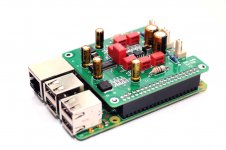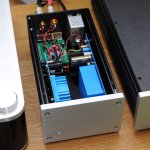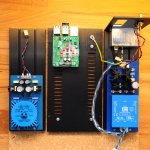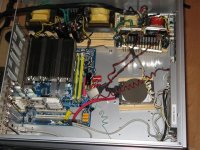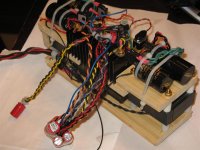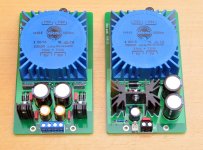Hello,
I have developed an new dac for the raspberry pi. About a year ago I built a big version based on the PCM1794 with separate power supplies and I'm still pleased with it. Btw. I still like the BurrBrown sound signature, if there is any, and I prefer it over the newer 32bit dacs. In my ears its more musically and real.
I was wondering how small it can be without lots of compromises in sound quality and started developing a hat dac for the raspi. I chosed the PCM1793 with I had good results in the past. The schematic is nearly the same like the datasheet, except a few changes in the analog filter stage. Here the OPA1642 with Jfet inputs gave the best in my ears. Finally it is ready and with some changes in resistors and capacitors its damn near on his big brother.
A separate power supply is necessary, I'm using linear power supplies for the raspberry and the dac. Other tries with one supply for all failed. So an external power supply for the dac is a must for proper HiFi.
As player software I'm using Moode player. This all is running on a Raspi3.
I have developed an new dac for the raspberry pi. About a year ago I built a big version based on the PCM1794 with separate power supplies and I'm still pleased with it. Btw. I still like the BurrBrown sound signature, if there is any, and I prefer it over the newer 32bit dacs. In my ears its more musically and real.
I was wondering how small it can be without lots of compromises in sound quality and started developing a hat dac for the raspi. I chosed the PCM1793 with I had good results in the past. The schematic is nearly the same like the datasheet, except a few changes in the analog filter stage. Here the OPA1642 with Jfet inputs gave the best in my ears. Finally it is ready and with some changes in resistors and capacitors its damn near on his big brother.
A separate power supply is necessary, I'm using linear power supplies for the raspberry and the dac. Other tries with one supply for all failed. So an external power supply for the dac is a must for proper HiFi.
As player software I'm using Moode player. This all is running on a Raspi3.
Attachments
hi LaxAnErde,
Congratulations, great project. I have thought of doing this for so long but never did it!
I use a PCM1796 DAC for normal day to day usage and have bought the PCM1794 and done a "basic" HAT PCB outline with no components.
What drivers do you use for the PCM1973?
regards
Congratulations, great project. I have thought of doing this for so long but never did it!
I use a PCM1796 DAC for normal day to day usage and have bought the PCM1794 and done a "basic" HAT PCB outline with no components.
What drivers do you use for the PCM1973?
regards
Member
Joined 2009
Paid Member
Hi,
thanks.
About the questions:
thanks.
About the questions:
- the dac don't need a special driver, runs with generic and hifiberry drivers, as well as the drivers for PCM1794 based dacs
- for the PCM1793 there is no possibilty to run in NOS, the internal digital filter is used
- for the Pi I'm using a linear power supply with LM350 regulator
- the power input filter a from Schaffner, 1A / 230V
Hi Greg,
a have got a couple of bare boards, if interested send me an pm.
There are kits and assembled dacs available here (at the moment in german only, for help send me a message):
https://dial-audio.jimdo.com/shop/
For me thats more easy to manage than a group buy.
Regards
Alex
a have got a couple of bare boards, if interested send me an pm.
There are kits and assembled dacs available here (at the moment in german only, for help send me a message):
https://dial-audio.jimdo.com/shop/
For me thats more easy to manage than a group buy.
Regards
Alex
Alex
Thanks... PM on the way!
Greg in Mississippi
P.S. I forgot to add try some things on your Pi & DAC supplies... 1st, consider using the LT3083 regulator instead of the LM350 for the Pi supply... the more modern regulator made a worthwhile improvement in my setups versus using older LT1083 regulators.
2nd, I've been playing around with using .33F/5.5v Supercaps as local reservoirs as mentioned in Joe Rasmussen's thread here: http://www.diyaudio.com/forums/digi...ring.html?highlight=alternative+dac+filtering and used in this new R-Pi DAC here: http://www.diyaudio.com/forums/vend...-rpi.html?highlight=alternative+dac+filtering and here: http://www.diyaudio.com/forums/digi...-hat.html?highlight=alternative+dac+filtering. You also see Supercaps used in this thread I believe: http://www.diyaudio.com/forums/digi...mods.html?highlight=alternative+dac+filtering .
I've tried them on processor supplies (for R-Pi and for the processor/DSP in a Sony HAP Z1-ES) and on DAC Analog-side supplies (so far just on the PCM1795 in the Sony HAP Z1-ES). Results for me have been very positive, though they take several weeks to finally come on song. I suggest one at the input of the 5v to the R-Pi and at the PCM1793's Analog-side 3.3v supply.
Finally on powering the Pi, people had reported best results powering the Pi via the expansion pins, bypassing some of the protection devices on the micro-USB feed. I haven't tried this myself as I've only powered them via the expansion pins, but that's another thing worth trying.
Thanks... PM on the way!
Greg in Mississippi
P.S. I forgot to add try some things on your Pi & DAC supplies... 1st, consider using the LT3083 regulator instead of the LM350 for the Pi supply... the more modern regulator made a worthwhile improvement in my setups versus using older LT1083 regulators.
2nd, I've been playing around with using .33F/5.5v Supercaps as local reservoirs as mentioned in Joe Rasmussen's thread here: http://www.diyaudio.com/forums/digi...ring.html?highlight=alternative+dac+filtering and used in this new R-Pi DAC here: http://www.diyaudio.com/forums/vend...-rpi.html?highlight=alternative+dac+filtering and here: http://www.diyaudio.com/forums/digi...-hat.html?highlight=alternative+dac+filtering. You also see Supercaps used in this thread I believe: http://www.diyaudio.com/forums/digi...mods.html?highlight=alternative+dac+filtering .
I've tried them on processor supplies (for R-Pi and for the processor/DSP in a Sony HAP Z1-ES) and on DAC Analog-side supplies (so far just on the PCM1795 in the Sony HAP Z1-ES). Results for me have been very positive, though they take several weeks to finally come on song. I suggest one at the input of the 5v to the R-Pi and at the PCM1793's Analog-side 3.3v supply.
Finally on powering the Pi, people had reported best results powering the Pi via the expansion pins, bypassing some of the protection devices on the micro-USB feed. I haven't tried this myself as I've only powered them via the expansion pins, but that's another thing worth trying.
Last edited:
Hi Greg,
I had always good results with the LM350 or even with 78S05 supplies. The most of the noise of their power rail comes the Pi itself. And I had also no problems while booting etc. The USB loads are SSD, USB-stick and a WLAN adapter. So I didn't consider another regulators.
The LT3083 is quite expensive. In which way there are improvements for the Pi?
Powering the Pi via the expansion pins I never tried. I heard about improvements for Pi1, especially for USB loads. Since the power managing at the Pi2 and Pi3 is better I don't believe in more improvements. But trial makes wise.
About the Supercaps: I have tried a lot of different capacitors in the supply line of the DAC and analog stage. Makes all a difference, most in the tonal matter and clarity of the high frequencies. In the end also by personal preferences. The Supercaps are not really designed for this application. In my opinion it can be also an another big capacitor.
I have to read Joe Rasmussen's thread later.....
I had always good results with the LM350 or even with 78S05 supplies. The most of the noise of their power rail comes the Pi itself. And I had also no problems while booting etc. The USB loads are SSD, USB-stick and a WLAN adapter. So I didn't consider another regulators.
The LT3083 is quite expensive. In which way there are improvements for the Pi?
Powering the Pi via the expansion pins I never tried. I heard about improvements for Pi1, especially for USB loads. Since the power managing at the Pi2 and Pi3 is better I don't believe in more improvements. But trial makes wise.
About the Supercaps: I have tried a lot of different capacitors in the supply line of the DAC and analog stage. Makes all a difference, most in the tonal matter and clarity of the high frequencies. In the end also by personal preferences. The Supercaps are not really designed for this application. In my opinion it can be also an another big capacitor.
I have to read Joe Rasmussen's thread later.....
On the LT3083 as a reg for the Pi, my experiences with this started during the period of 2008-2011 when I was running a motherboard-based player following the cMP/cPlay formula. I started with additional filter caps on the output of the ATX SMPS, then to a Peter Daniel-inspired linear-supplied PicoPSU (Linear-Hybrid supply), then to a fully Linear ATX24/P4 supply. Along the way I added separate linear supplies to all of the required peripherals... HDD/SSD, keyboard, mouse, monitor. I started with LT1084 regulators... moved to John Bau optimized versions of the same for the critical regulators, then to Belleson hi-current regulators. Each move improved perceived sound quality, leading me to the conclusion that digital circuits perform best with the widest-bandwidth, highest current, yet lowest noise power supplies.
Specifically on the Pi, I have tried 3 different supplies in my setups... On using the LT3083 regulator built-up on the K&K Audio power supply board, an Uptone Audio LPS-1, and the low-$ SMPS recommended by UltraFi in this post: http://www.diyaudio.com/forums/digi...y-dac-pro-hw-mods-anybody-10.html#post4940489 . All sounded different, with the LPS-1 the cleanest yet least dynamic-sounding, the SMPS the most dynamic yet grundgy, and the mains-powered K&K supply in the middle on both parameters. This leads me to believe that the power supply is just as critical for the Pi setup as I found on the cMP/cPlay setup... and the LT3083 was my minimum choice, providing a quieter background and more detailed & dynamic sound back in those days over the LT1084.
AND from my experiences back in those days, there are also benefits to be gained by separately powering add-on peripherals such as WiFi adapters & USB-connected storage.
On the Supercap, where I've added one at the feed from a linear supply into the processing unit (either Pi or Sony HAP Z1-ES), it has lifted the sense of perceived dynamics to that of the switch-mode supplies without reducing cleanliness & clarity PLUS adding bass extension and solidity. A win all around in adding a <$5 USD part.
On powering the Pi via the expansion header, that is the only way I've done it in my setups, just by matter of convenience. BUT in the post referenced above, UltraFi mentioned his listening tests on that.
Finally, on the Joe Rasmussen thread, there isn't much useful after the first 100 posts or so, it quickly became a pile-on from the 'measurements are everything' crowd and no additional important information was added after that. That finally resulted in the thread being closed.
Later!
Greg in Mississippi
Specifically on the Pi, I have tried 3 different supplies in my setups... On using the LT3083 regulator built-up on the K&K Audio power supply board, an Uptone Audio LPS-1, and the low-$ SMPS recommended by UltraFi in this post: http://www.diyaudio.com/forums/digi...y-dac-pro-hw-mods-anybody-10.html#post4940489 . All sounded different, with the LPS-1 the cleanest yet least dynamic-sounding, the SMPS the most dynamic yet grundgy, and the mains-powered K&K supply in the middle on both parameters. This leads me to believe that the power supply is just as critical for the Pi setup as I found on the cMP/cPlay setup... and the LT3083 was my minimum choice, providing a quieter background and more detailed & dynamic sound back in those days over the LT1084.
AND from my experiences back in those days, there are also benefits to be gained by separately powering add-on peripherals such as WiFi adapters & USB-connected storage.
On the Supercap, where I've added one at the feed from a linear supply into the processing unit (either Pi or Sony HAP Z1-ES), it has lifted the sense of perceived dynamics to that of the switch-mode supplies without reducing cleanliness & clarity PLUS adding bass extension and solidity. A win all around in adding a <$5 USD part.
On powering the Pi via the expansion header, that is the only way I've done it in my setups, just by matter of convenience. BUT in the post referenced above, UltraFi mentioned his listening tests on that.
Finally, on the Joe Rasmussen thread, there isn't much useful after the first 100 posts or so, it quickly became a pile-on from the 'measurements are everything' crowd and no additional important information was added after that. That finally resulted in the thread being closed.
Later!
Greg in Mississippi
Attachments
Thanks for the infos.
Seems there is room for more experiments, will try the LT3083 sooner or later.
Last week I just changed a transformer from a flat pcb transformer, I have choosen because of separate windings to avoid backflow of hf-noise from the Pi into the mains, with a toroidal transformer. Was surprised the toroidal was better. Measurements made no difference. Will try both in 2 equal setups to see what makes the difference.
Seems there is room for more experiments, will try the LT3083 sooner or later.
Last week I just changed a transformer from a flat pcb transformer, I have choosen because of separate windings to avoid backflow of hf-noise from the Pi into the mains, with a toroidal transformer. Was surprised the toroidal was better. Measurements made no difference. Will try both in 2 equal setups to see what makes the difference.
Thanks for the infos.
Seems there is room for more experiments, will try the LT3083 sooner or later.
Last week I just changed a transformer from a flat pcb transformer, I have choosen because of separate windings to avoid backflow of hf-noise from the Pi into the mains, with a toroidal transformer. Was surprised the toroidal was better. Measurements made no difference. Will try both in 2 equal setups to see what makes the difference.
Looking forward to hearing how that works for you.
I had a similar experience recently on transformers... I have 2 set of 'generic' digital source power supplies, each having a source supply (R-Pi, BBB, SDTrans, etc.), 4 digital supplies, an output stage supply, & a mute circuit supply. The 1st used 2 flat-styled transformers for the digital supplies with each of the 2 secondaries each transformer feeding 1 supply. The 2nd used 4 toroids. Both used the same rectifiying diodes and filter caps.
The 2nd was a good SQ lift over the 1st. OF course, there are likely several thing contributing in this case:
1. Separate transformer / rail
2. Higher current / lower output impedence transformers
3. Full-wave rectification instead of full-wave bridge.
4. Style of transformer.
Still, the difference surprised me.
I guess everything really DOES matter!
Greg in Mississippi
Hi Greg,
totally agree.
The first power supplies are finished. Simple and well proven concept for both supplies.
For the audio and DAC it is based on MC7815/MC7915 from ON semiconductors. They have better specs than the common 7815/7915. Less noise and on my tests much better than LM317.
For the Raspi stable power and high peak current is required. The L78S05 gives 2A and up to 3A more at peak. I have selected them to about 5,05-5,1V to be in a safe area also for Pi3.
All my Raspis works fine with this supply, as well as added WLAN-stick, SSD and a USB stick. The power consumtion for a Pi3 incl. the devices is about a max current of 0,8A.
totally agree.
The first power supplies are finished. Simple and well proven concept for both supplies.
For the audio and DAC it is based on MC7815/MC7915 from ON semiconductors. They have better specs than the common 7815/7915. Less noise and on my tests much better than LM317.
For the Raspi stable power and high peak current is required. The L78S05 gives 2A and up to 3A more at peak. I have selected them to about 5,05-5,1V to be in a safe area also for Pi3.
All my Raspis works fine with this supply, as well as added WLAN-stick, SSD and a USB stick. The power consumtion for a Pi3 incl. the devices is about a max current of 0,8A.
Attachments
I just played around with the settings and drivers for my DAC. So here the right I2S drivers for using:
Moode Player 3.1:
-driver: Generic-2 I2S (rpi dac) or RPi-DAC
-advanced kernel supports 64fs bitblock
-if you prefer upsampling, try 32bit/192kHz, sounds better than upsampling to24bit/192kHz, output stream will be always 24bit.
Volumio 1.55
-driver: Hifiberry DAC
-resampling to 24bit plays all files
Volumio2:
-driver: Generic I2S or Hifiberry DAC
-still no resampling, 16bit files not supported
PiCore Player:
-driver: RPiDAC
other players will follow...
Moode Player 3.1:
-driver: Generic-2 I2S (rpi dac) or RPi-DAC
-advanced kernel supports 64fs bitblock
-if you prefer upsampling, try 32bit/192kHz, sounds better than upsampling to24bit/192kHz, output stream will be always 24bit.
Volumio 1.55
-driver: Hifiberry DAC
-resampling to 24bit plays all files
Volumio2:
-driver: Generic I2S or Hifiberry DAC
-still no resampling, 16bit files not supported
PiCore Player:
-driver: RPiDAC
other players will follow...
Over the past number of years I have been growing and upgrading my Squeezebox Duet players in my home. The availability and cost effectiveness of the Raspberry Pi has made the transition easy and the availability of Pi Hat DACs has given me the freedom to get away from a one vendor solution except for the Logitech Media Server software. I have no current plans to change the status quo. In addition, there is the DIY component which is immeasurable if you are a hardware junkie like me.
I recently assembled a Pi3 and the Dial-dac to add to my collection of players which are connected to my main listening system which is tube based. Depending on the mood I am in I will select a Rpi and attached DAC and stream music for the whole listening session. All my music is flac based. I am not a trained musician or could even class myself as an amateur audiophile since I do not have the vocabulary or the ability to describe what I am hearing. The two main things I listen for are the artist’s control of his/her instrument and the artistic touch of the arrangement(s).
Here are some of my comments of the Dial-Dac listening :
Artist: Renee Rosnes, A Time for Love, Track “ A time for Love”.
Comment: The bass player appears to be having a great time and also the accompanying instruments come across clear.
Artist: Steve Tyrell, A New Standard, Track “ On the sunny side of the side of the street”.
Comment: The bass is clean and the guitar solo at 1min 20secs is enjoyable.
Artist: Diana Panton, To Brazil with Love, Track “ Dreamer”
Comment: There are many instruments heard and listening to them weave in and out clearly is pleasurable.
Artist: Toots Thielemans, The Brasil Project, Track “ Bluesette”
Comment: There are many instruments playing together at times or sometimes solo and low to loud. The musical effort comes out clear and distinct. I wish they made more music like this.
Summary: Some DACs will sound very musical with some of my music. Some DACs (1 or 2) not so much. My music collection covers 4 to 5 decades and I have found that reproduction of music CDs (re-releases) of the earlier years is nowhere as good as the originals and leaves a lot to be desired. Having a multiplicity of DACs to try is a workable listening option for me. The Dial-DAC will stay.
I recently assembled a Pi3 and the Dial-dac to add to my collection of players which are connected to my main listening system which is tube based. Depending on the mood I am in I will select a Rpi and attached DAC and stream music for the whole listening session. All my music is flac based. I am not a trained musician or could even class myself as an amateur audiophile since I do not have the vocabulary or the ability to describe what I am hearing. The two main things I listen for are the artist’s control of his/her instrument and the artistic touch of the arrangement(s).
Here are some of my comments of the Dial-Dac listening :
Artist: Renee Rosnes, A Time for Love, Track “ A time for Love”.
Comment: The bass player appears to be having a great time and also the accompanying instruments come across clear.
Artist: Steve Tyrell, A New Standard, Track “ On the sunny side of the side of the street”.
Comment: The bass is clean and the guitar solo at 1min 20secs is enjoyable.
Artist: Diana Panton, To Brazil with Love, Track “ Dreamer”
Comment: There are many instruments heard and listening to them weave in and out clearly is pleasurable.
Artist: Toots Thielemans, The Brasil Project, Track “ Bluesette”
Comment: There are many instruments playing together at times or sometimes solo and low to loud. The musical effort comes out clear and distinct. I wish they made more music like this.
Summary: Some DACs will sound very musical with some of my music. Some DACs (1 or 2) not so much. My music collection covers 4 to 5 decades and I have found that reproduction of music CDs (re-releases) of the earlier years is nowhere as good as the originals and leaves a lot to be desired. Having a multiplicity of DACs to try is a workable listening option for me. The Dial-DAC will stay.
Alex,
I finally got your Dial Audio RPi DAC running last night. After an hour or so of run-time, it was sounding pretty good. I don't want to do any serious comparisons until it has at least a couple of weeks to run and settle in... but what I heard likely puts it in my top tier of favorite RPi DACs. We'll see...
I have it on an Allo.com Kali on a Pi running piCorePlayer 1.22 with the generic I2S driver selected.
Power for the RPi is a DIY'd linear supply based on the K&K Audio Low Voltage Power Supply here:
K&K Audio | Other kits
Go for their 12watt one and that is very similar to what I used.
The Kali is powered by an Uptone Audio LPS-1 set to 7V and energizing a 5v Belleson regulator.
I tried 2 different power setups on the Dial DAC... a Jan Didden Silent Switcher energized by another Uptone LPS-1 (again set to 7V) and a +-15v set of small shunt regulators (design provided by a friend in the industry, sorry I can't share, but consider them somewhat simpler Salas) energized by a hefty +-24v linear supply. They both had their strengths, as of last night I preferred the shunt regulator pair, but that might change with more runtime on the Silent Switcher.
All in all I think I'm going to be very happy adding this to my stable of RPi DACs.
Greg in Mississippi
I finally got your Dial Audio RPi DAC running last night. After an hour or so of run-time, it was sounding pretty good. I don't want to do any serious comparisons until it has at least a couple of weeks to run and settle in... but what I heard likely puts it in my top tier of favorite RPi DACs. We'll see...
I have it on an Allo.com Kali on a Pi running piCorePlayer 1.22 with the generic I2S driver selected.
Power for the RPi is a DIY'd linear supply based on the K&K Audio Low Voltage Power Supply here:
K&K Audio | Other kits
Go for their 12watt one and that is very similar to what I used.
The Kali is powered by an Uptone Audio LPS-1 set to 7V and energizing a 5v Belleson regulator.
I tried 2 different power setups on the Dial DAC... a Jan Didden Silent Switcher energized by another Uptone LPS-1 (again set to 7V) and a +-15v set of small shunt regulators (design provided by a friend in the industry, sorry I can't share, but consider them somewhat simpler Salas) energized by a hefty +-24v linear supply. They both had their strengths, as of last night I preferred the shunt regulator pair, but that might change with more runtime on the Silent Switcher.
All in all I think I'm going to be very happy adding this to my stable of RPi DACs.
Greg in Mississippi
Alex,
A quick update... as your Dial Audio DAC came on song quickly, I realized that with only film and electrolytic capacitors, it will break in quickly. In my experience, Black Gates, ceramic, Supercaps, and Teflon caps all take a 1-3 weeks, but other film caps, other electrolytics, and most resistors & silicone seem to settle in 1-2 days.
So I've listened a bit more and more critically today and like it a good bit. I haven't yet compared it to my reference units, but it is edging close to them and definitely in my top tier of R-Pi DACs.
This is with the DAC being fed through a Kali reclocker w/power as I described above.
Thanks for sharing... and as I assemble the bare board I got from you I'll keep you appraised of progress.
Greg in Mississippi
A quick update... as your Dial Audio DAC came on song quickly, I realized that with only film and electrolytic capacitors, it will break in quickly. In my experience, Black Gates, ceramic, Supercaps, and Teflon caps all take a 1-3 weeks, but other film caps, other electrolytics, and most resistors & silicone seem to settle in 1-2 days.
So I've listened a bit more and more critically today and like it a good bit. I haven't yet compared it to my reference units, but it is edging close to them and definitely in my top tier of R-Pi DACs.
This is with the DAC being fed through a Kali reclocker w/power as I described above.
Thanks for sharing... and as I assemble the bare board I got from you I'll keep you appraised of progress.
Greg in Mississippi
Hi Greg,
nice to hear. And I'm glad it works with the Kali. Would be interesting to the difference with/without the Kali.
The break in time is about 24h, this is what I have noticed. Btw. All my devices got a several hours test, so they should be ready to play without a lot of burn in.
Alex
nice to hear. And I'm glad it works with the Kali. Would be interesting to the difference with/without the Kali.
The break in time is about 24h, this is what I have noticed. Btw. All my devices got a several hours test, so they should be ready to play without a lot of burn in.
Alex
Anyone likes to build a DIAL-DAC?
I have got a couple of new boards and parts.
If you have problems soldering the smd parts, I can provide presoldered boards and finished ones.
Send me a pm for questions and costs.
I have got a couple of new boards and parts.
If you have problems soldering the smd parts, I can provide presoldered boards and finished ones.
Send me a pm for questions and costs.
An externally hosted image should be here but it was not working when we last tested it.
- Status
- This old topic is closed. If you want to reopen this topic, contact a moderator using the "Report Post" button.
- Home
- Source & Line
- Digital Line Level
- DAC for Raspberry Pi
